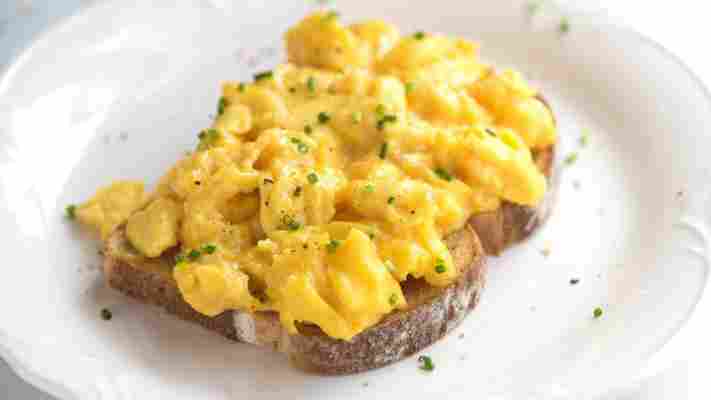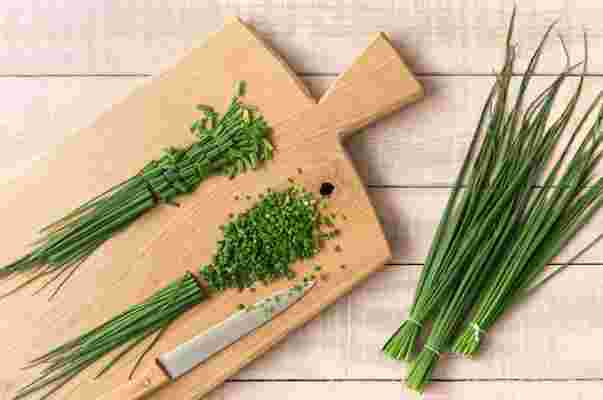Nailing good scrambled eggs is like trying to brew the perfect cup of tea – you’ll likely fail time and time again trying to recreate that one perfect instance where you got it just right, where you happen to let the tea steep just long enough, add just that right amount of cream or sugar to achieve that singular spot-on experience.

You’ll wake up the next morning and enthusiastically try to brew that same cup of tea again, measuring out just the right amount, timing how long you steep, even using the same cup … but somehow it’s not right. The magic just isn’t there. Can anyone relate?
Maybe we’re just projecting …
Scrambled eggs are one of the simplest breakfast foods you can make, and yet – like that cup of tea or a really good steak – getting it just right each time somehow evades us. One of the biggest contributing factors is that since so many people prep their eggs differently it becomes easy to over-complicate the dish, adding too many ingredients, cooking them for overly long, or getting the wrong consistency.
Seriously, though, there are so many different takes on how to cook scrambled eggs:
You can even learn to scramble your eggs “the Gandalf way!”
If there’s a method for making scrambled eggs, we’ve tried it. We love what these guys showed us, and we’ve found a way of our own that we think is just right. Let’s get started!
How to make perfect scrambled eggs
What you’ll need:
2 eggs butter (preferably stick) olive oil thyme chives salt black pepper

First off, it’s two eggs per portion . The fresher the better, and you can tell by checking out the membrane when you crack it. Alton Brown explains here just what that looks like:
Crack your eggs into a bowl (careful not to get any shell in there!) and it’s time to get your seasonings. All you’ll need is salt, black pepper , and – the often under-utilized – chives. Add just a pinch of the salt, grind in a couple cranks of black pepper, and then add the chives. The chives are going to add a light, delicate onion flavor, and it’s very easy to accidentally add too much, especially when you’re using fresh. Trust us, though, adding just about a teaspoon or less of chives will make a dramatic difference.

If you’re looking for more ways to use common spices, check out our article here .
Using either a fork or a whisk, vigorously stir the eggs in the bowl until it’s all one uniform golden color.
Next it’s time to get the skillet ready. Be sure to opt for a smaller pan, as it will help with the mixing and folding we’re going to be doing. Surface area is a factor here, and the less of it you have to deal with the better; you’ll get better-developed egg curds and you’ll have more control of the pan and cooking time.
Put in a half tablespoon of butter, then pour a touch of extra virgin olive oil over it. Dust the pan sparsely with thyme (fresh is better!) and get your spatula on stand-by. Once you turn up the heat, you’ll be done with cooking process in about 2-5 minutes. If you want toast with your eggs (yum), then pop it in the toaster now.
Go ahead and turn the heat up to high. You can optionally throw in some minced garlic here, but it isn’t necessary. Once the butter and oil combination starts to lightly simmer, pour the mixture right into the bowl with your eggs ! Give it a quick stir, then immediately pour that mixture back on the pan. Turn down your heat.
TIP: When you’re raising or lowering the heat, judge it by the size of the flame , not what the dial says.
Now comes the quick and delicate cooking process. If you want your eggs to have a heartier, more solid consistency just push the egg mixture around the pan, being sure to fold and move them about quickly – eggs cook extremely fast and you don’t want these to get overdone.
If you’re looking for smoother, richer, runnier scrambled eggs (like you’d put on toast), it’ll take slightly longer. Keep your flame very low from start to finish. The moment your egg mixture hits the pan, take the whole thing off the heat. Stir them constantly to keep the curds uniform in shape. Keep the pan off the stove top for a good 20 or 30 seconds, then return them to the heat, still stirring. Repeat this until your eggs achieve the desired consistency, then pour them directly over your toast.
Sprinkle a few more chives (or fresh parsley!) on top there you have it: Perfectly scrambled eggs. You might be surprised we didn’t use milk or cream at any point. It’s because you don’t need either one to get good, creamy eggs. It’s a common misconception. On the contrary, adding a dairy product like milk will actually leech the moisture from your eggs, resulting in making them come out more rubbery and dry. The best scrambled eggs won’t need milk or cream at all.
Agree with our method? Let us know any add-ons or changes you made in the comments below!
More from Softonic
The best burger recipe in the world ►
This delicious 10-minute low-cal salad will fill you up! ►
How to take peanut butter and jelly to the next level ►
9 delicious alternatives to peanut butter ►
